New Materialism, Thing Theory, and Ecocriticism are affecting current performance and lead to productions like The Plastic Bag Store (2020) by Robin Frohardt, Chimpanzee (2019) by Nick Lehane, Aanika’s Elephants by Annie Evans, and PackRat by Renee Philippi. This focus on material as living brings thoughtful attention to puppetry as a discipline, but may merely reinforce what puppeteers already know. While this theory which, linked to climate change, is likely to grow thematically in coming years, can puppetry get us beyond our tendency to demand a human or humanized subject as protagonist? Is it possible to develop a new animism through actual practice with manipulating material? How can working with and writing about things make an actual impact, artistically, philosophically, and politically?
Kathy Foley is a Research Professor and Distinguished Professor Emerita at University of California, Santa Cruz. She is a member of the UNIMA-International Publication Commission and Heritage Commission. This research was supported by the UCSC Committee on Research and the Arts Research Institute.
“New materialism” and “material performance” have emerged as terms in theatre discourse since the 1990s. Since puppetry is a discipline where objects and not manipulators are spotlighted, one understands why a theoretical strain attributing agency to things attracts: the moment you pick up a puppet you find yourself constrained by what it will let you do. Terms like “new materialism” (Gamble, Hanan and Nail 2019) “thing theory” (Brown 2001, 2016), and “vibrant matter” (Bennett 2010) are current in puppetry’s academic circles (see “Introduction” in Posner, Orenstein, and Bell 2014, 1-12 and Kent 2018). The popularity of the terms comes from twenty-first century politico-social developments and a culture of academia which rewards new theorizations that may fit the need of the times.
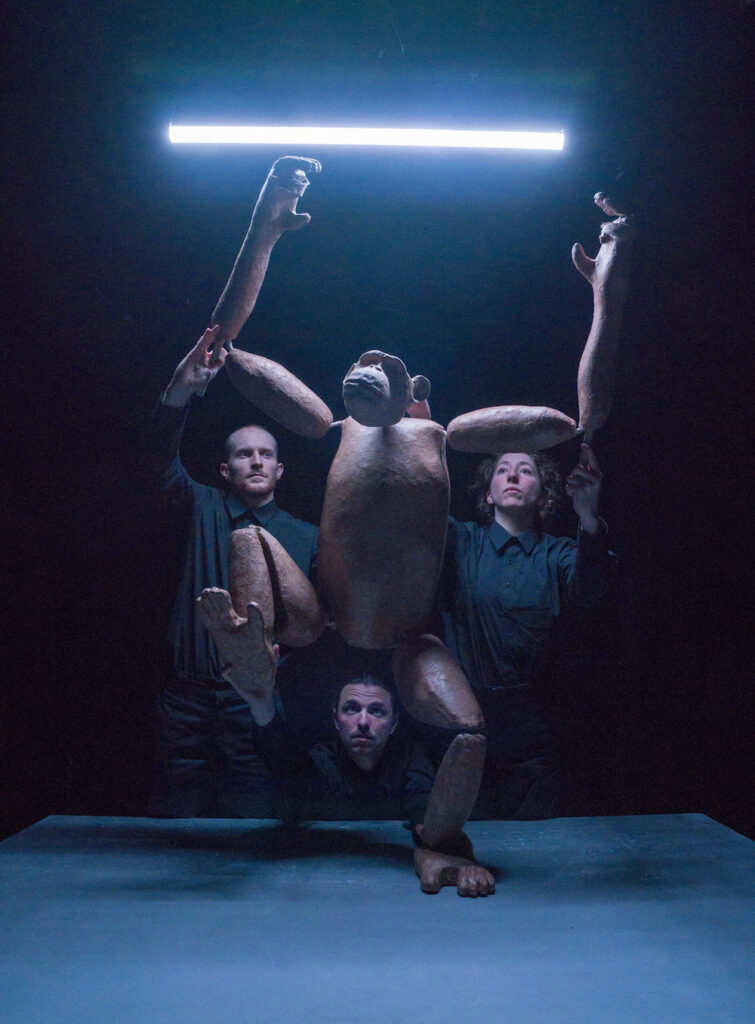
Attentiveness to things is part of the “posthuman turn.” As “postmodern” became the moniker of theatre that deconstructed race, gender, and class circa 1970, and as theorist Hans-Thies Lehmann’s “postdramatic” was popularized in the theatre studies of the 1990s, noting the move from narrative toward digital-age immersive performance as visual and experiential events, so humanists have coined the term “posthuman,” responding to issues of environmental change. Theorists assert humans must give equal attention to things, animals, and the environment if our species is to sustain itself (Figure 1). In posthuman discourse, things, including puppets, are thus promoted from objects that humans use in self-interested ways, to subjects that humans must work with collaboratively; humans and things are co-performative, together making something happen. Additionally, in art as in life, people and things are not just symbols (signs) but they actually do. Gamble, Hanan, and Nail (2019: 111) note:
The common motivation for this “materialist turn” is a perceived neglect or diminishment of matter in the dominant Euro-Western tradition as a passive substance intrinsically devoid of meaning. In what has become a kind of de facto motto, new materialists routinely emphasize how matter is ‘alive,’ ‘lively,’ ‘vibrant,’ ‘dynamic,’ ‘agentive,’ and thus active.
Thing theory is a subset of ecocriticism, a strain which responds to the world with an environmentalist ethos.[1]
My aim in this essay is not to address scientific issues implied nor to deeply engage with the politics of this critical theory which sees matter as active, but merely to note that “new materialism” is having an impact on puppetry, conceptually and content-wise (i.e. giving rise to plays where animals and things are foregrounded). It makes sense: puppetry’s agent is non-human matter, so the form invites puppet artists and audiences to think beyond human bodies. We collaborate with our materials to make meaning.
Brunella Eruli (2009) discusses puppetry as both a metaphor of our relation to the ultimate and a symbol of human limitation:
The puppet represents the invisible double of the human, from a dual perspective: the bright, positive side stimulates the spirit that is freed from the gravity of the matter; the negative side unveils the mind’s hidden impulses. Those two aspects are fundamentally linked, and thus reinforce the troubling idea conveyed by the puppet: mysterious strings bind the animate to the inanimate, life to death, light to shadow. In the fourth of the Duino Elegies (1923), Bohemian-Austrian poet Rainer Maria Rilke considers the puppet not as an imitation of mankind, but as a model for it: he argues that the human being must learn to become a puppet, giving up any pretension to be the centre of the world, and becoming “thing.”
A persistent metaphor of the human/puppet relation, as seen from the marionette bridge, is with the puppet master as god pulling the figure’s strings. And another view, from below, is with the human as puppet—hungry matter, a Punch driven by forces that animate him. Basil Jones observes: “The puppet’s Ur-narrative is […] more fundamental than storytelling. It is the quest for life itself” (Jones 2011, 62). The thing wants to move and in some sense needs the manipulator, at least if it is to enter human attention.
John Bell discusses the “uncanny” figure (taking this term from Sigmund Freud and Ernst Jentsch), “We could say that the essence of puppet, mask, and object performance is the animation of the dead world by living humans” (in Posner, Orenstein, and Bell 2014, 43). In the same volume Claudia Orenstein asserts we are in “a puppet moment” where the animated figure is more present and she queries how does “one understand subjectivity, agency, or characters in this intermingling of flesh and matter” (see pp. 2-3), while Dassia Posner defines puppetry “as the human infusion of independent life into lifeless but not agentless, objects in performance” (p. 5). All these views assert the puppet is a lively thing.
Here I will briefly discuss aspects of thing theory (matter matters) and ask where the theory leads. We live in an era when borders—race, gender, nationality—are patrolled and many are accused of appropriation when they speak for that which they are not. Are puppeteers misled in thinking they can represent the material other? Yet is it not the unique ability of puppetry to displace ego? Many may find the release to other possibilities is puppetry’s greatest gift.
Matter Matters
Current thinking beyond the human comes from dis-ease with the late twentieth-century Western use of the non-human, accelerating extinctions and climate change.[2] Scientists currently debate if and when we entered the Anthropocene (“age of man,” a humanly impacted geological era), though the term is already widespread among humanists.[3] The environmental critique confronts the human-centrism in Western discourse which gauges man as “the measure of all things.” Decentering “man,” argue new materialists, will allow us to go beyond the dead end of global degradation.
Of course, the ecocritical or posthuman turn is actually an extension of post-World War II critical theorizing including French-modeled deconstructionism and resultant culture wars. Practitioners have used theatre (among other arts) to address injustices and urge reform—to do something. The deconstruction technique, used to point out social issues (class/economic privilege, Euro-American dominance, colonialism, patriarchy, etc.), has called out environmental misuse and non-sustainable consumption. “You did it” was the complaint of ethnically discriminated against BIPOC (Black, Indigenous, Person of Color) or the international colonized and thrown at Euro-American elites in the wake of World War II. “He did it” was the protest of feminists in the 1970s. “They did it” became the cry of the non-heteronormative or disabled toward heterosexuals and the able-bodied by the 1980s. “You did it” is the plaint of youth now toward boomers as together we confront climate collapse and economic stasis post-2000. Whoever traditionally was the “subject” (male, Caucasian, upper class, heteronormative, able bodied, human) is called out in socially-conscious works in the name of the disempowered (female, person of color/colonized, lower class, differently gendered, disabled, and animal-vegetable-mineral). The previously objectified calls for reparative justice. In the arts, such social justice initiatives have affected both content and form. I will merely give a few examples of post-2000 puppetry works that touch on some ecology awareness or environmental issues.
Robin Frohardt’s UNIMA citation-winning 2020 work, The Plastic Bag Store, presents viewers with a grocery store installation, but all the colorful wares are crafted from single-use plastic bags (see Frohardt 2023 for an excerpt). Vivie Behrens (2022) in her April 7, 2022 review described the work as:
illuminating the comic depth of our habituation to consumer culture. Through surprising disruptions, clever punch-lines, and thoughtful puppeteering, The Plastic Bag Store pokes fun at the ease with which we produce and discard lasting materials, particularly single-use plastics.
The filmed narrative Frohardt created for the installation begins with a story (depicted via shadow puppets) of disposable ancient Greek pots. Next it explores (using a rod puppet) the predicament of a current museum janitor cleaning a gallery where the fragile Greek vases are now enshrined and the janitor wages war against pervasive plastic waste. The tale climaxes in the distant future where a new museum values a precious archeological find—a plastic bottle in which the janitor enclosed a note, “Your extreme climate is probably our fault, . . . the only animals you probably have left to eat are jellyfish and cockroaches” (Collins-Hughes 2020). Frohardt envisioned her work “fueling the fire of public outrage (Frohardt 2021 [5’ 34”]).
Puppets representing misuse of animals are likewise featured in current shows even as spectacles of human domination of the animal world are disappearing. For example, Ringling Brothers Circus in 2017 closed after a 146-year run due to litigation and brand damage from animal rights activists. Puppets are taking the animal’s place in narratives to rouse cross-species empathy. Of course, masks and puppets have long been used to represent the animals (consider Hanuman, the monkey general in the Indian and Southeast Asian Ramayana or Sun Wukong, Monkey King in China’s Journey to the West), but these are often stories of human-animal cooperation. Currently we see more tales of animal exploitation wrought by humans as artists try to access the animal’s viewpoint rather than anthropomorphizing the creature concerned.
Take the example of the National Theatre’s innovative Warhorse (2007) with its heroic stallion, Joey.[4] The play was realized with the stunning design and deft manipulation techniques developed by Handspring Puppet Company’s Adrian Kohler and Basil Jones. This tale of a horse plunged into World War I carnage as a draft animal triumphed in London, New York, and round the globe for over a decade under different directors but the same puppet design team. Roma Torre (2011) in NY1 wrote:
The true stars of this production are the animals, . . . Lifelike without any attempt to conceal the artifice, the creatures are magnificent, a thrilling synthesis of art and imagination. It wasn’t until after heading home that I stopped to think that I had just cried over a horse that was actually made up of several props held together by visible handlers.[5]
The humans of this play based on a children’s book by Michael Morpurgo are included in the story, but the puppet horse is centerstage.
Nick Lehane’s Chimpanzee (2019) is smaller scale (Figures 2 and 3), but, again, animal-centric, presenting “an hour in a theater, a day in a biomedical facility, and a lifetime in the mind of a chimpanzee” (Lehane 2019). The wordless play explores the experience of a chimp brought up in a human home, but, with age, abandoned to biomedical experimentation, a common occurrence. Reviewers praised the acute observation that resulted in masterful manipulation and strong directorial choices. Reviewer Rosie Kelly (2020) commented: “A device towards the finale [which] sees the puppeteers themselves [Rowan Magee, Andy Manjuck, and Emma Wiseman] represent walls of the cage . . . puppetry fans will delight at the genius of the technique.” She then continues: “If an object can be brought to life to represent an animal, and can be entertaining, make us laugh, make us cry, make us feel, then why is there any need to have real animals in circus?” Humans are asked to identify with the non-human “other.”
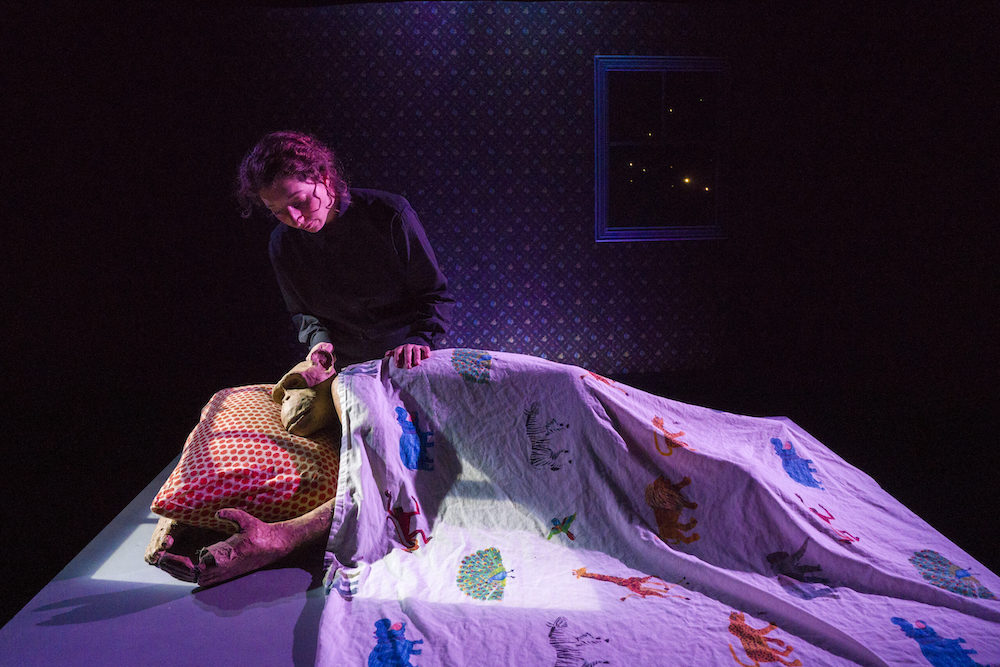
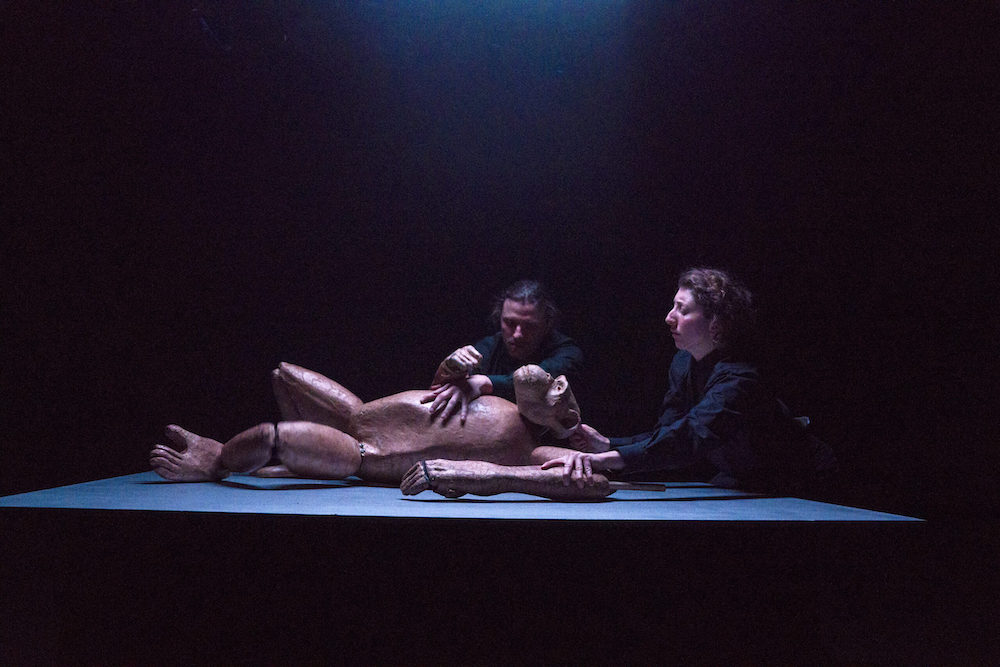
At the July 2023 Puppeteers of America Festival Aanika’s Elephants by Annie Evans was featured. The work was produced by Feisty Elephant, Pam Arciero Productions, and Little Shadow Productions (Jean Marie Keevins). It was directed and produced by Pam Arciero with rod and black light puppets designed by Marty Robinson. The filigree outer forms of the animal figures were striking modernist sculpture and human forms could be abstractly evoked via a hat held high by one blacklight puppeteer and a single white glove for the figure’s gesturing hand. Evans is a writer for Sesame Street and Arciero, Robinson, and others have been puppeteers on the show for many years as well as leading the summer training programs in puppetry at the O’Neill Center in Connecticut. Actress Jimmica Collins played the eponymous Aanika.
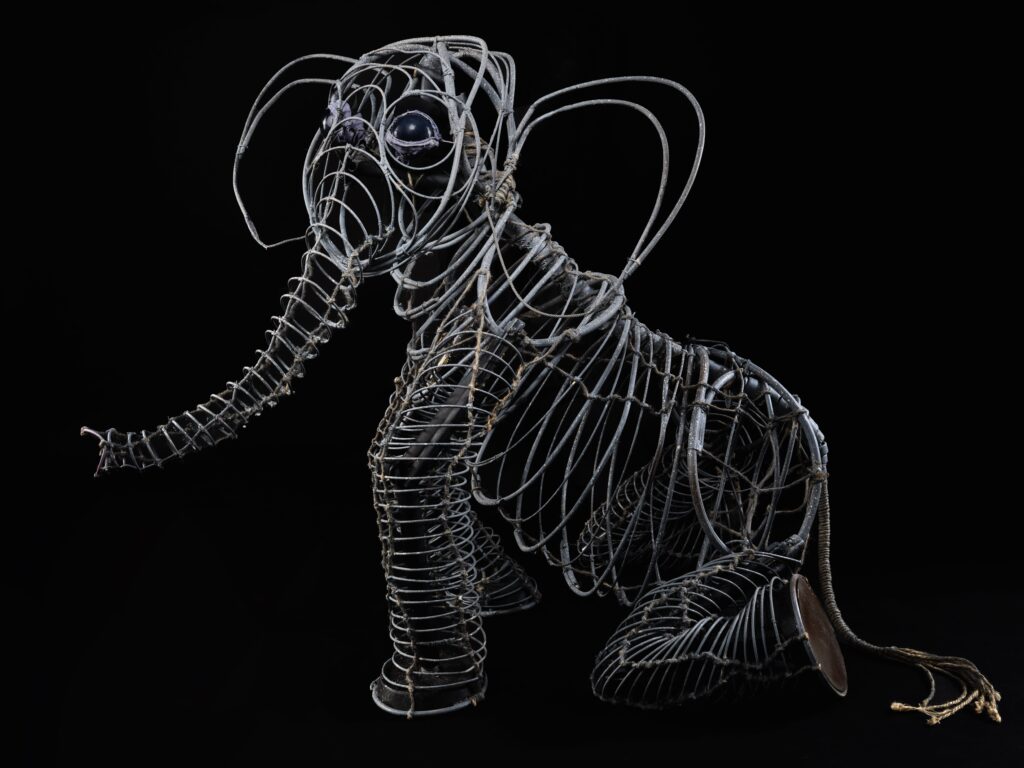
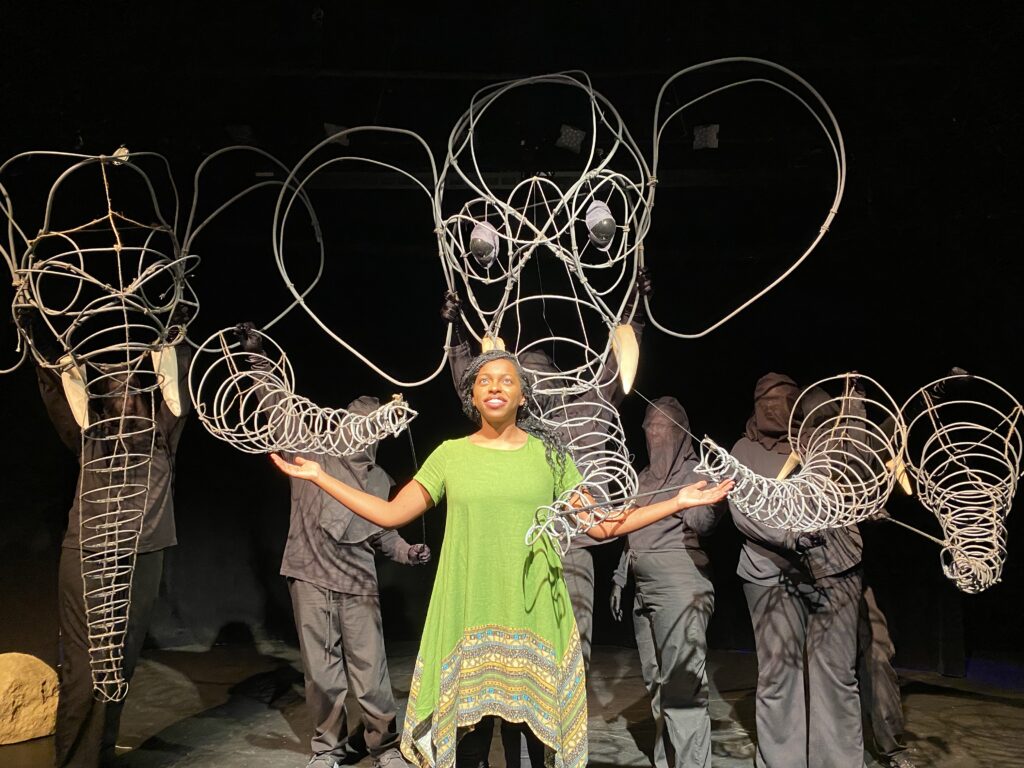
The story was set in a Kenyan wildlife sanctuary where Aanika’s father works and where the girl and a baby elephant (Little) form their bond. When Aanika is herself orphaned and must escape from an abusive uncle, Little and she are adopted by a herd of elephants on the savannah. Issues of elephantine social structure including matriarchal leadership and current threats of ivory poaching were foregrounded. The creators’ background in educational TV was evident in the child-sensitive approach to broaching difficult issues (child sexual abuse/incest, killing of protected species, the ivory trade). While the script gives greater focus to the human character than Lehane’s Chimpanzee, animals’ rights and plights still prevail. Evans’ work was inspired in part by participation in an Earthwatch Institute project: “Earthwatch connects people with scientists worldwide to conduct environmental research and empowers them with the knowledge they need to conserve the planet.”[6] Evans noted:
When I returned to New York [from travel in Kenya ], I pondered how to write a story about these beautiful animals and their amazing culture. I churned out scripts for children’s television shows for fifteen more years, waiting for an idea to come to me. It finally did…young orphan girl and an orphan elephant in the bush becoming their own loving family… and that was it for the moment! (Annie Evans quoted in Speakeysie News Service 2023)
The result was a script and collaborative effort of many in New York’s professional TV puppetry community. Performers were there to use puppetry to teach and entertain.
Concrete Temple Theatre’s PackRat was also presented at the 2023 Puppeteers of America Festival. It was written and directed by Renee Philippi and designed by Carlo Adinolfi. The piece, inspired in part by Watership Down, features a pack rat (Bud) accused of being overly friendly with humans who destroy the environment.
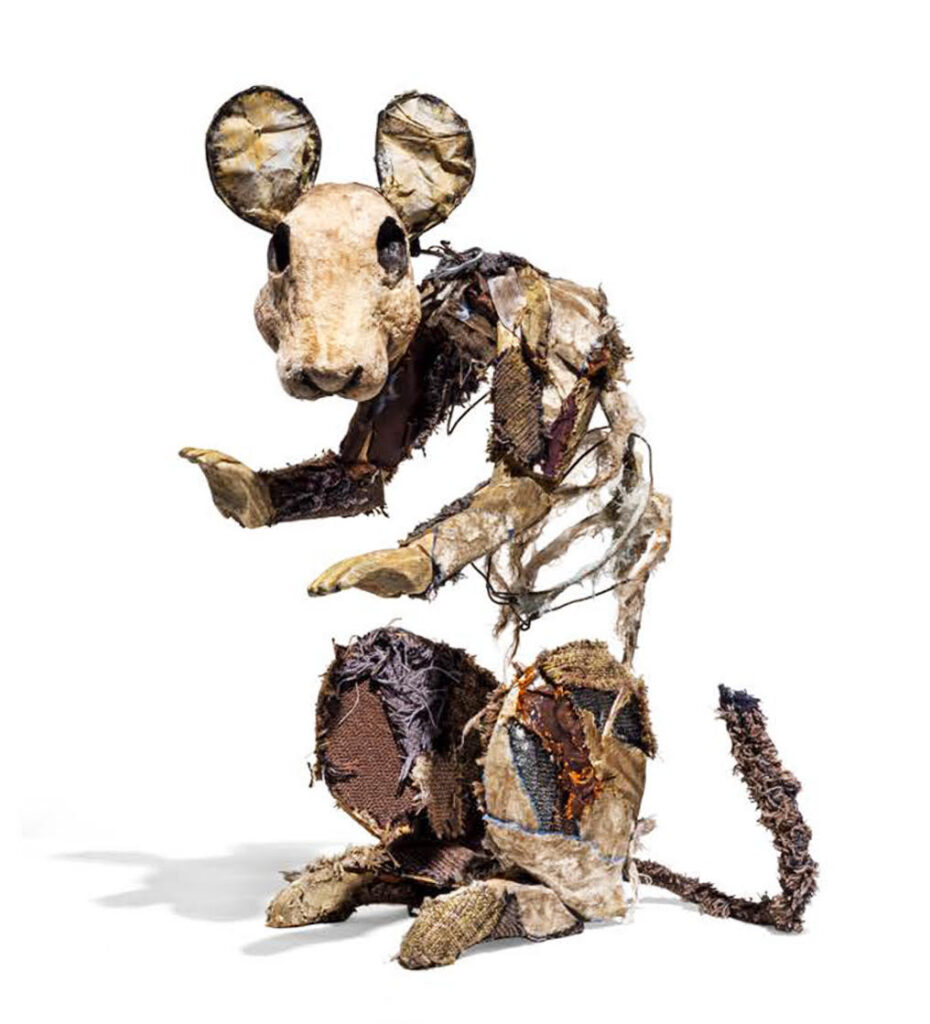
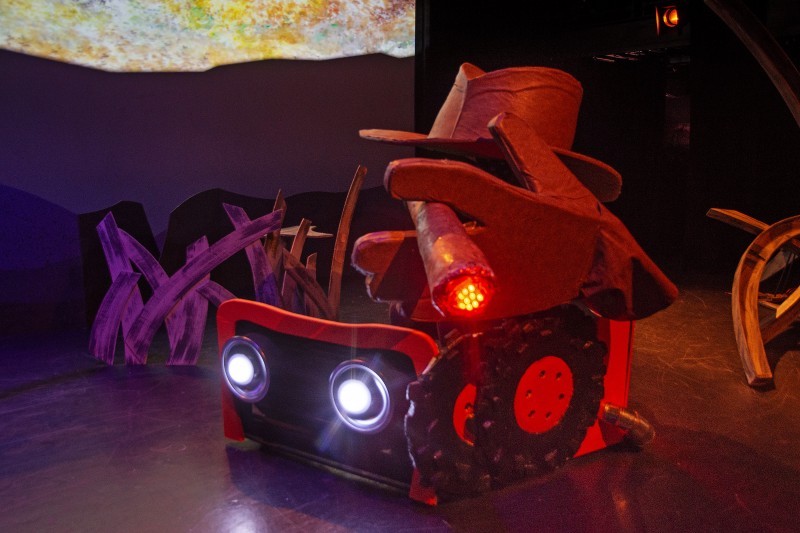
The effort was in part inspired by a residency at the Montello Foundation, a Nevada arts residency program founded by photographer Stefan Hagen. This foundation is dedicated to artists who foster “our understanding of nature, its fragility and our need to protect it.”[7] The puppets with boney rib cages and extended paws but recognizable well-sculpted heads had rough textures, as if made out of desert materials. When a fire caused by a careless human destroys the animal habitat, the pack rat (Bud) is ostracized by the other creatures because of his affinity for things human. He is judged a traitor to the animal world though still gaining some empathy from his friend, a jack rabbit named Firestone. One review noted:
The presentation of the humans as faceless beings with huge, disproportionate cowboy hats and appendages lends an appropriate sense of the animal’s perspective. The main components of the cleverly constructed set are sculptural curves that suggest blades of grass . . . [and] abstract suggestions of place. (Ziegler and Richards 2020)
Director Renee Philippi noted in her personal email (15 August 2023):
Fire is important in PackRat not only in terms of narrative, but because one of the big things we wanted to comment on when we started working on the play was wildfires. When we started working on the show in 2018, wildfires were a problem, but nothing like what they are now. [She was writing during the 2023 fire devastation in Maui.] There is a quote that is attributed to Albert Einstein:
“A human being is a part of the whole called by us, universe, a part limited in time and space. They [humans] experience themselves, their thoughts and feelings as something separated from the rest, a kind of optical delusion of their consciousness. This delusion is a kind of prison for us, restricting us to our personal desires and to affection for a few persons nearest to us. Our task must be to free ourselves from this prison by widening our circle of compassion to embrace all living creatures and the whole of nature in its beauty.”
We [Concerte Temple] hope in our own small way that our play PackRat can inspire people to be better stewards of all living things
The desert PackRat, addicted to human detritus, is caught betwixt and between. The piece ends with no clear solution. Lehane, Evans, and Philippi all depicted animals with anthropomorphic leanings to bring viewers into these narratives. Sustainability and sharing the planet with justice toward fellow creatures were repeated themes.
Thing theory is a step beyond cross-species empathy in animal narratives and argues the power of the artwork, the thing in itself, is a catalyst. Humans must fully open to the material object in both its form and being. What is our actual experience of the materials which make up the world, and how can we see them as agential? Alfred Gell (1992, 1998) is credited in helping introduce this “thing” centered ontology in critical theory. Gell’s anthropological and semiotic approach called for acknowledging the empowered thing in a socio-cultural frame. In “The Technology of Enchantment and the Enchantment of Technology” (1992), later expanded into Art and Agency (1998), Gell discussed things that act on viewers and their communities, including art, idols, fetishes, and sorcery objects. For example, elaborate carved prows of Trobriand Islanders’ canoes are artworks made to dazzle and debilitate trade partners, enabling economic gain for the merchant mariners. Such enchantment, normally attributed to “primitive art,” Gell equates with Western art, which he sees as a “religion” of the privileged modern West: these art things have social agency within their object-human community network.
Bill Brown (2001, 2016) extended Gell’s discussion: “When you say that there is some thing about that bust of Balzac that creeps you out, the thing is present and potent, even if it can’t immediately be named or known” (2016, 23). Philosopher of science Bruno Latour (2004) in “Why Has Critique Run Out of Steam?” demanded postmodern ideological criticism actually deal with the material, the real.[8] Jane Bennett in her work Vibrant Matter discussed the entanglement of humans and nonhuman, positing that full attention to material would alter the “way we treat the world as object” (2010, 113). Art historians—especially those who deal with the earlier eras where, for example, a statue of a saint could be envisioned as the living presence of an actual holy person—agreed (see Jurkowlaniec, Matyjaszkiewicz, and Sarnecka 2018). Both Karen Barad (2003) and Tim Ingold (2011) have reminded us that things have independence from human interface and that matter matters.[9] Ingold’s essay asks readers to put a rock on the desk and touch it—the world exists and impacts. When we craft or manipulate a thing, we can only get the thing to do what its materiality and our tools, again made of material, allow.
This diverse theoretical, practical, and socio-political discussion collapses the Elizabethan hierarchical great chain of being to a flat earth: animals and things are accorded equal subjectivity. Humans are “working with,” shaping, and manipulating the potentialities already inherent in the matter or its figuration. Discussions sometimes lean on traditions of animism, but also are related to the explorations of abstract modernism. For example, Skye Strauss in her 2022 dissertation discusses choreographer Alwin Nikolais (1910-1993) as an American precedent for contemporary theatre/puppetry explorations of the thing. Nikolais
required the dancers to become depersonalized onstage, as Nikolais weighed them down with heavy discs, extended their bodies with poles, or encased them in fabric to make them into new, alien beings. Nikolais’ dance abstraction challenged the boundaries of the human body through material means and pushed dancers into a space of experimentation . . . [providing] opportunity to collaborate with, rather than control, the material world” (Strauss 2022, 54-55).[10]
Alissa Mello discusses exploring the materiality of mud or fabric while studying in 2009 with important French visual theatre/puppet master Philippe Genty:
The performer needs to pay attention to the details of a particular material: its sound, texture, smell, taste, weight, and such. Genty asks that one try to move deeper into a material . . . the need to ‘be careful of creating a situation [a narrative] in advance as it can block one’s relationship and dialogue with the material’ (Mello 2014, 94).
Genty uses a concept of animism to describe the puppeteer’s relations with the thing (See Jim Henson’s The World of Puppetry with Philippe Genty [1985]). More recently Australian shadow puppeteer Lynne Kent has explored related ideas: “The texture of foam for example, offers different possibilities to metal or wood. I have asked other puppeteers about their relationship to material . . . it is a very intimate relationship that a puppeteer has to an object or material” (Kent 2019). Discussing significant Australian puppeteers, Kent notes:
[Joe] Blanck talked about how he “pushes a material just to see what will happen” . . . extending the possibilities of latex to accidentally create what he describes as “an amazing skin effect”. Scott Wright talked about working with Tyvec [a synthetic building material] in the early days of creating puppets with his company Erth. Scott said that they “pushed it to its limits by treating it, heating it, stretching it, distorting it, trying to make a textural skin”.[11]
These artists, who delve into the materiality and the non-human have been increasingly active since the 1990s, and can be seen as exponents of “thing-ness,” exploring leather, bone, wood, foam, plastic, fabric to find its liveliness and transformations, devising narratives within their improvisation and crafting. The medium is always part of the message.
In the shadow of carbon dioxide clouds people are remembering the world is alive. In 2017 New Zealand granted personhood to the Whanganui River, source to sea, in both physical and metaphysical dimensions (O’Donnell and Talbot-Jones 2018, Associated Press 2022). Such attention to the materiality of things is impacting politics and is on the minds of puppeteers.
Conclusion
This essay began by exploring contemporary theory that advocates changes in human treatment of the material world and noted that ecocriticism or new materialism is having an impact on puppetry and its themes. This will only grow as we see the ever increasing results of climate change and energy of a younger generation aiming to change course on misuse of our planet. While I have, of course, made broad generalizations I believe the posthuman moment may help explain why puppets/masking has gained increased focus and why its technique of attentiveness and collaboration with the material world is likely to persist in performances to come. Attentiveness to the realms beyond the human is an intrinsic part of puppetry, a discipline where the new materialism does not seem “new” but built into the genre itself.
[1] Ecocriticism and New Materialism are aligned. Nasrullah Mambrol writes:
Ecocriticism is the study of literature and environment from an interdisciplinary point of view where all sciences come together to analyze the environment and brainstorm possible solutions for the correction of the contemporary environmental situation (Mambrol 2016).
See Buell (1995), Glotfelty and Fromm (1996), Morton (2010) and Garrard (2014) for more on the movement. Kershaw (2007, 2016) is one example of a theatre theorist contributing to the movement.
[2] For example, Orenstein (Posner, Orenstein, and Bell 2011, 3) argues this material turn boosts object theatre in the Western hierarchy of the arts, explaining in part the greater use of puppets on the Euro-American stage.
[3] Man is seen as having accelerated impact on the environment since the industrial revolution and especially since 1945 with the introduction of nuclear bombs, rise in carbon dioxide emissions, and other human effects on things and species. Though geologists have yet to accept Anthropocene as a formal geological age, the Anthropocene Working Group of the International Commission on Stratigraphy proposed such a designation to the International Geographical Congress in 2016. The term Anthropocene was used in the 1980s by Eugene F. Stoermer but became popular since 2000 due to the work of Nobel prize-winning chemist Paul J. Crutzen.
[4] The stage adaptation was done by Nick Stafford. The National Theatre, West End, and Boadway versions were directed by Marianne Elliott and Tom Morris and horse choreography was by Toby Sedgwick. More recently the Life of Pi has grabbed attention as has King Kong on Broadway.
[5] For video presentation see Adrian Kohler and Basil Jones (2011) in their TED talk, https://www.youtube.com/watch?v=h7u6N-cSWtY.
[6] See Earthwatch (n.d.) website (https://earthwatch.org/) for its mission and Speakeysie News Service (2023) for Evan’s discussion of how travel with the organization helped inspire her script. https://speakeysie.com/2023/08/03/broadway-bound-aanikas-elephants-premiere-and-sesame-street-panel-coming-to-center-for-puppetry-arts/https://speakeysie.com/2023/08/03/broadway-bound-aanikas-elephants-premiere-and-sesame-street-panel-coming-to-center-for-puppetry-arts/.
[7] See the Montello Foundation (n.d.). https://www.montellofoundation.org/pages/montello_retreat_main.htm and for discussion of the piece see Ziegler and Richards (2020).
[8] In a lecture at Stanford in 2003, Latour unleashed his wrath on what some of the deconstruction, when unattached to the material/real, had wrought:
American kids are learning the hard way that facts are made up, that there is no such thing as natural, unmediated, unbiased access to truth, that we are always prisoners of language, that we always speak from a particular standpoint, and so on, while dangerous extremists are using the very same argument of social construction to destroy hard-won evidence that could save our lives (Latour 2004: 227).
Latour decried some branches of theory as touting:
Enter here, you poor folks. After arduous years of reading turgid prose, you will be always right, you will never be taken in any more; no one, no matter how powerful, will be able to accuse you of naïveté, that supreme sin, any longer? Better equipped than Zeus himself you rule alone, striking from above with the salvo of antifetishism in one hand and the solid causality of objectivity in the other (Latour 2004: 239).
[9] See Skye Strauss’s 2022 dissertation for extensive discussion of Ingold’s ideas and furthers the application of thing theory to puppetry. Her case studies are Alwin Nikolais, Cirque Mechanics, and Kneehigh Theatre, and she coins the term “phenomenological materiality.”
[10] Nikolais’ German influences were imparted through his study with Hanya Holm who trained in the expressionism of Mary Wigman. Wigman often used masks and manipulated costumes, and drew on the ideas of Émile Jaques-Dalcroze, Rudolf Laban, and perhaps Oskar Schlemmer.
[11] See also Kent 2018. For examples of Joe Blanck’s work see A Blanck Canvas.com (n.d.), at https://ablanckcanvas.com/our-story/. For Scott Wright of Erth (Environmentally Recycled Theatre) see Walton (2020) at https://www.southbendtribune.com/story/entertainment/arts/2020/02/12/erths-puppeteers-re-create-prehistoric-aquarium/116076556/).
References
A Blanck Canvas. com. n.d. “Our Story.” https://ablanckcanvas.com/our-story/, accessed 25 Sept. 2022. Associated Press. 2022.
“New Zealand River’s Personhood Status Offers Hope to Māori.” U.S. News.com. 15 Aug. 2017. https://www.usnews.com/news/world/articles/2022-08-15/new-zealand-rivers-personhood-status-offers-hope-to-maori, accessed 24 Sept. 2022.
Barad, Karen. 2003. “Posthumanist Performativity: Toward an Understanding of How Matter Comes to Matter.” Signs 28, No.3: 801-83, https://doi.org/10.1086/345321. accessed 25 Sept. 2022.
Behrens, Vivie. 2022. “‘The Plastic Bag Store,’ critiques overproduction… by overproducing?” Sightlines, 7 April. https://sightlinesmag.org/the-plastic-bag-store-critiques-overproduction-by-overproducing, accessed 14 Sept. 2022.
Bell, John. 2014. “Playing with the Eternal Uncanny.” In The Routledge Companion to Puppetry and Material Performance, ed. by Dassia Posner, Claudia Orenstein, and John Bell, 61-68. London and New York: Routledge.
Bennett, Jane. 2010. Vibrant Matter: A Political Ecology of Things. Duke University Press. https://doi.org/10.2307/j.ctv111jh6w, accessed 28 Sept. 2022.
Brown, Bill. 2001. “Thing Theory.” Critical Inquiry 28, No. 1: 1–22. http://www.jstor.org/stable/1344258, accessed 28 Sept. 2022.
_____. 2016. Other Things. Chicago. University of Chicago Press.
Buell, Lawrence. 1995. The Environmental Imagination: Thoreau, Nature Writing, and the Formation of American Culture. Cambridge and London: Harvard University Press.
Collins-Hughes, Laura. 2020. “Don’t Eat the Breakfast Cereal, Its Made of Plastic.” 1 Nov. https://www.nytimes.com/2020/11/01/theater/plastic-bag-store-times-square.html, accessed 20 Sept. 2022.
Eruli, Brunella. 2009. “Myth of the Puppet – A Western Perspective.” World Encyclopedia of Puppetry Arts. https://wepa.unima.org/en/myth-of-the-puppet-a-western-perspective/, accessed 17 Sept. 2022.
Earthwatch. n.d. https://earthwatch.org/, accessed 10 Aug. 2023.
Frohardt, Robin [Interviewee]. 2021. “A Guided Tour of Robin Frohardt’s The Plastic Bag Store” Times Square NYC. Jan 21. https://www.youtube.com/watch?v=B6rF0oYAoT4, accessed 15 Sept. 2022.
_____. 2023. “The Plastic Bag Store (Excerpt).” PAJ: A Journal of Performance and Art 45, No. 1 (133): 56-63.
Gamble, Christopher N., Joshua S. Hanan, and Thomas Nail. 2019. “What Is New Materialism?” Angelaki 24, No, 6: 111-134. https://philosophyofmovementblog.com/2019/11/19/what-is-new-materialism/, accessed 19 Sept. 2022.
Garrard, Greg, ed. 2014. The Oxford Handbook of Ecocriticism. Oxford: Oxford University Press.
Gell, Alfred. 1992. “The Technology of Enchantment and the Enchantment of Technology.” In Anthropology, Art and Aesthetics, ed. by J. Coote and A. Shelton, 40-66. Oxford: Clarendon. [http://www.xenopraxis.net/readings/gell_technologyenchantment.pdf, accessed 28 Sept. 2022].
______. 1998. Art and Agency: An Anthropological Theory. Oxford: Clarendon.
Genty, Philippe [Interviewee]. 1985. Jim Henson’s The World of Puppetry with Philippe Genty. [see https://muppet.fandom.com/wiki/The_World_of_Puppetry_with_Philipe_Genty, accessed 28 Sept. 2022].
Jurkowlaniec, Grażyna, Ika Matyjaszkiewicz, and Zuzanna Sarnecka. 2018. The Agency of Things in Medieval and Early Modern Art: Materials, Power and Manipulation. New York: Routledge. https://doi.org/10.4324/9781315166940, accessed 28 Sept. 2022.
Glotfelty, Cheryll, and Harold Fromm, eds. 1996. The Ecocriticism Reader: Landmarks in Literary Ecology. Athens and London: University of Georgia.
Ingold, Tim. 2011. “Materials Against Materiality.” In Being Alive: Essays on Movement, Knowledge and Description, 19-32. Abingdon, Oxon; New York: Routledge.
Jones, Basil. 2011. “Puppetry, Authorship and the Ur-Narrative.” In The Routledge Companion to Puppetry and Material Performance, ed. by Dassia N. Posner, Claudia Orenstein and John Bell, 61-68. London and New York: Routledge.
Kelly, Rosie. 2020. “‘Chimpanzee’ by Nick Lehane.” The Circus Diaries. 10 Feb. 2020. https://thecircusdiaries.com/2020/02/10/chimpanzee-by-nick-lehane/, accessed 28 Sept. 2020.
Kent, Lynne [interviewee]. 2018. “Interview with Lynne Kent” by Hamish McCormick. Fluke the Blog. https://www.carnivalcinema.com.au/interview-with-lynne-kent/, accessed 20 Sept. 2022.
_____. 2018. “Working with Things: An Exploration of Materiality in the Puppet Theatre.” Garland Magazine. 11 September. https://Garlandmag.Com/Article/Working-With-Things/, accessed 20 Sept. 2022.
Kershaw, Baz. 2007. Theatre Ecology: Environments and Performance Events, Cambridge: University Press.
_____. 2016. “Projecting Climate Scenarios, Landscaping Nature, and Knowing Performance: On Becoming Performed by Ecology.” Green Letters 20, No. 3: 270-289. DOI: 10.1080/14688417.2016.1191999, accessed 28 Sept. 2022.
Kohler, Adrian, and Basil Jones. 2011. “The Genius Puppetry behind War Horse: Handspring Puppet Company.” [TED talk] 20 March. https://www.youtube.com/watch?v=h7u6N-cSWtY, accessed 13 Sept. 2022.
Latour, Bruno. 2004. “Why Has Critique Run Out of Steam? From Matters of Fact to Matters of Concern.” Critical Inquiry 30 (Winter): 225-248. https://site.douban.com/widget/notes/5335979/note/209468033/, accessed 28 Sept. 2022.
Lehane, Nick. 2019. https://nicklehane.com/chimpanzee, accessed 28 Sept. 2022.
Mambrol, Nasrullah. 2016. “Ecocriticism; An Essay.” 27 Nov. https://literariness.org/2016/11/27/ecocriticism/, accessed 14 Sept. 2022.
Mello, Alissa Marie. 2014. Puppets, Presence, and Memory: The Training Methods and Workshop Techniques of Compagnie Philippe Genty, Stuffed Puppet, and Inkfish’s Three Good Wives. Ph. D., Royal Holloway, Univ. of London. https://www.semanticscholar.org/paper/Puppets%2C-presence%2C-and-memory-%3A-the-training-and-of-Mello/fa014c71798bee47c43950071de0bcc229a090a3, accessed 28 Sept. 2022.
Morton, Timothy. 2010. The Ecological Thought. Cambridge: Harvard University Press.
Philippi, Renee. 2023. Personal email, August 15.
O’Donnell, Erin L., and Julia Talbot-Jones. 2018. “Creating Legal Rights for Rivers: Lessons from Australia, New Zealand, and India.” Ecology and Society 23, No. 1. https://www.jstor.org/stable/26799037, accessed 28 Sept. 2022.
Montello Foundation. n.d. https://www.montellofoundation.org/pages/montello_retreat_main.htm, accessed 10 Aug. 2023.
Posner, Dassia, Claudia Orenstein, and John Bell. 2014. “Introduction.” In The Routledge Companion to Puppetry and Material Performance, ed. by Dassia N. Posner, Claudia Orenstein, and John Bell, 1-13. London and New York: Routledge.
Speakeysie News Service. 2023. “Broadway-Bound ‘Aanika’s Elephants’ Premiere and Sesame Street Panel Coming to Center for Puppetry Arts.” 3 Aug. https://speakeysie.com/2023/08/03/broadway-bound-aanikas-elephants-premiere-and-sesame-street-panel-coming-to-center-for-puppetry-arts/, accessed 10 Aug. 2023.
Strauss, Skye Elizabeth. 2022. “Materiality Matters: On the Power of ‘Things’ in Collective Creation.” Ph. D. dissertation, Northwestern University.
Torre, Roma. 2011. “War Horse: Broadway Reviews.” Broadway World. https://www.broadwayworld.com/reviews/War-Horse, accessed 17 Sept. 2022.
Walton, Jack. 2020. “Erth’s Puppeteers Re-create Prehistoric Aquarium.” South Bend Tribune. 12 Feb. https://www.southbendtribune.com/story/entertainment/arts/2020/02/12/erths-puppeteers-re-create-prehistoric-aquarium/116076556/, accessed 24 Sept. 2022.
Ziegler, John R., and Leah Richards 2020. “Review: Puppet Play ‘PackRat’ Holds Many Treasures,” Thinking Theatre NYC, 2 Feb. https://www.thinkingtheaternyc.com/2020/02/review-puppet-play-packrat-holds-many.html, accessed 10 Aug. 2023.

